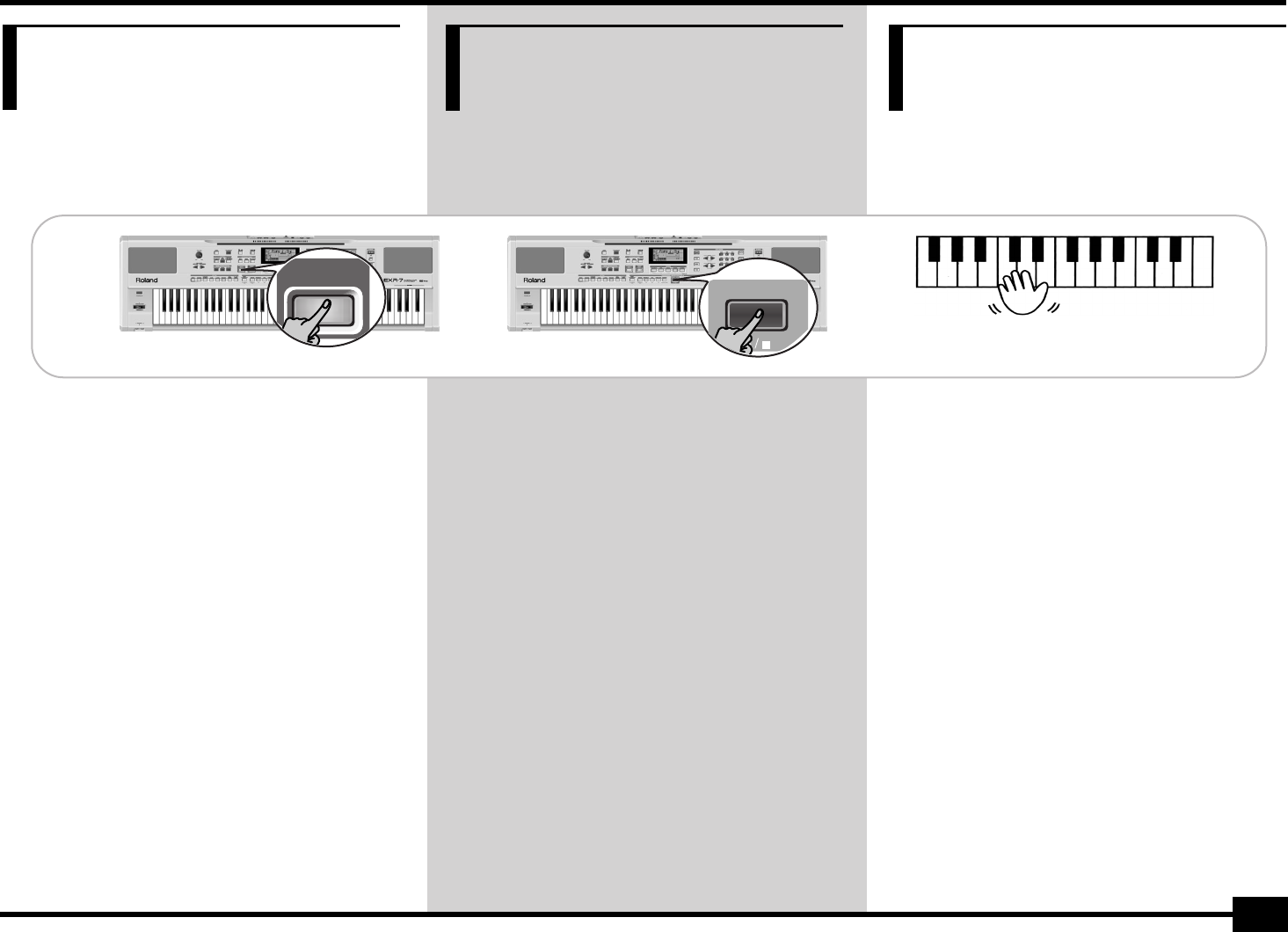
EXR-7
29
Aprovechemos ahora las ventajas de la función de acompa-
ñamiento del EXR-7. Esta función se denomina “Arranger”.
4. Interpretar con acom-
pañamiento (Arranger)
Activar/utilizar el Arranger
(1) Pulse el botón [ARRANGER¥BAND].
El botón se ilumina y el teclado se divide en dos mitades.
Las teclas que pulsa en la mitad izquierda se utilizan para
especificar la tecla del acompañamiento. La mitad dere-
cha del teclado le permite reproducir una sintonía en el
acompañamiento.
(2) Pulse el botón [START÷STOP] para iniciar la reproduc-
ción del Arranger.
El botón [START÷STOP] parpadea para indicar el tempo y
los tiempos. Tenga en cuenta que en la pantalla también
aparece una indicación BEAT que le indica dónde se
encuentra.
Nota: Si se ilumina el botón [ARRANGER¥BAND], al tocar en la
mitad izquierda del teclado mientras el Arranger está detenido,
sonará un sonido de cuerda estéreo (al que se le puede añadir un
sonido de bajo monofónico, consulte la sección “Auto Bass*:
estado y volumen” (p. 102)). La mitad izquierda del teclado, de
esta manera, no se enmudece (como en anteriores instrumentos
de acompañamiento de Roland). No obstante, esta función “EP
Chord” puede desactivarse (página 104).
(3) Toque un acorde (o sólo una nota) con la mano
izquierda.
Voyons à présent comment exploiter la fonction d’accompa-
gnement de l’EXR-7. Cette fonction s’appelle “Arranger”
(arrangeur).
Activation/utilisation de l’arrangeur
(1) Appuyez sur le bouton [ARRANGER¥BAND].
Le bouton s’allume et le clavier est divisé en deux moitiés.
Les touches que vous enfoncez dans la partie gauche per-
mettent de spécifier la tonalité de l’accompagnement. La
moitié droite du clavier permet de jouer une mélodie sur
l’accompagnement.
(2) Appuyez sur le bouton [START÷STOP] pour lancer le jeu
de l’arrangeur.
Le bouton [START÷STOP] clignote alors pour indiquer le
tempo et les battements. Notez que l’écran affiche aussi
une indication BEAT qui vous permet de vous repérer dans
la mesure.
Remarque: Quand le bouton [ARRANGER¥BAND] est allumé,
tandis que l’arrangeur est à l’arrêt, vous entendrez un son de
cordes stéréo (auquel vous pouvez ajouter une basse monopho-
nique) lorsque vous jouez dans la moitié gauche du clavier.
Voyez “Auto Bass*: statut et volume” (p. 102). La moitié gauche
du clavier n’est donc pas étouffée (comme c’était le cas sur les
anciens instruments Roland disposant d’un arrangeur). Vous
pouvez toutefois désactiver cette fonction “EP Chord”
(page 104).
(3) Jouez un accord (ou juste une note) de la main gauche.
4. Jeu avec accompagne-
ment (arrangeur)
Let us now take advantage of the EXR-7’s accompaniment
function. This function is called “Arranger”.
4. Playing with accompa-
niment (Arranger)
Starting/using the Arranger
(1) Press the [ARRANGER¥BAND] button.
The button lights and the keyboard is split into two
halves. The keys you press in the left half are used to
specify the key of the accompaniment. The right half of
the keyboard allows you to play a tune to the accompa-
niment.
(2) Press the [START÷STOP] button to start Arranger play-
back.
The [START÷STOP] button now flashes to indicate the
tempo and beats. Note that there is also a BEAT indica-
tion in the display that tells you where you are.
Note: If the [ARRANGER¥BAND] button lights, playing in the left
half of the keyboard while the Arranger is stopped will sound a
stereo string sound (to which you can add a monophonic bass
sound, see “Auto Bass*: status and volume” (p. 102)). The left
half of the keyboard is thus not muted (like on previous Roland
arranger instruments). This “EP Chord” function can be switched
off, however (page 104).
(3) Play a chord (or just one note) with your left hand.
ARRANGER
BAND
START / STOP
EXR-7_GBEF.book Page 29 Monday, April 19, 2004 3:36 PM


















